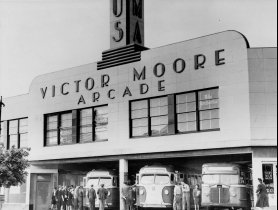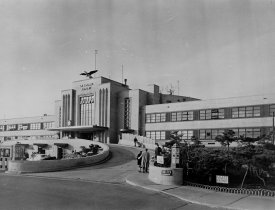The Twentieth Century Borough
One Hundred Years of Modern Architecture in Queens
June 9, 2002 through March 2, 2003
Queens saw two waves of explosive growth in the last century that have
come to define the physical make up of the borough. The two decades after the
First World War, followed by the two decades after the Second World War, saw
the borough transformed from a collection of independent towns separated by
acres under cultivation to a sprawling arm of the metropolis. The story is of a
wholly twentieth century borough shaped by larger social,
political, economic, and technological forces expressed in the local
architecture and planning of Queens. This exhibit explores the changing facets
of Modernism over a century of growth.
What is modern architecture in Queens?
|
The common definition of modern is often thought of as
contemporary… of the present. In architecture and planning of the
Twentieth Century, ‘modern’ often refers to the Modern
Movement. This movement with roots in the United States and Europe would by
mid century transform cities worldwide. Today, we also recognize other
movements in architecture and planning that can also be labeled
‘modern’ that fall outside of the cannon of the Modern Movement. What
all of these ‘modernisms’ have in common is a belief in progress.
Progress defined by new ideas, new materials, new technologies, toward a better
way of life. These ideas flourished and became reality in the open spaces of
Queensborough. After a century of modernism, the reality may not have always
lived up to the aspirations. Progress came at a price. Perhaps in hindsight,
this vision of progress appears flawed. However at the time, the intention was
to create something positive… keeping in mind that each generation builds
in a manner that reflects the vision of the times. The intention that ties the
various modernisms together across the Twentieth Century is the belief that
design, modern design, would lead to positive change. Today, across the
borough of Queens, you will find a century’s worth of these
‘aspirations of progress’. This architecture is chronicled in
The Twentieth Century Borough: One Hundred Years of Architecture
in Queens. |
 |
| Jackson Heights: Queens was a
laboratory for new ideas in housing in the twentieth century. The planned
community of Jackson Heights introduced several modern planning ideas of the
1920’s. Shown are the ‘Towers’ designed by Andrew J. Thomas in
1925, which illustrate ‘Garden Apartment ‘ planning- open space and
suburban amenities - within the confines of the city’s grid. |
The exhibit is designed to tell this story through compelling vintage
photographs and images in four parts:
- Early Modern Queens- 1900 to the First World War
- Inter-War Modernism -1920 to the Second World War
- Post-War Modernism – 1945-1975
- Modernism Today – 1975-2000
Early Modern Queens will introduce gallery goers to the first
years of development in the newly formed borough.
In 1898, the western townships of Queens County; Long Island City,
Newtown, Jamaica, and Flushing joined the consolidated city of Greater New York
to form Queens borough. (The eastern townships of Hempstead and Oyster Bay,
decline to join in the consolidation, and formed Nassau County.) The newly
consolidated city of New York now sprawled over five boroughs, over 360 square
miles. Its population stood at 3 million. Most of that population was
concentrated in Manhattan south of 96th Street and in the northwest
area of Kings County that contained the wards of the former city of Brooklyn.
While the borough of Queens possessed historic towns and villages that date to
the 17th Century, they were separated in 1900 by miles of open
space; fields, forests, farms. In the best spirit of the Progressive Movement
and its progeny the City Beautiful Movement, plans were made for a series of
improvements that would relieve the problem of congestion in the older,
built-up areas of the city while planning for the orderly growth of undeveloped
sections. A system of broad boulevards and new subway lines would tie
Manhattan’s business center to the historic towns of Queens, while opening
up undeveloped areas to commercial, industrial, and residential expansion.
Civic buildings were proposed and planned residential enclaves came into being.
Highlights of Early Modern Queens will include the Queensborough
Bridge, the reinforced concrete industrial lofts of Long Island City, the Dual
Contracts IRT/BMT Subway, and the experiments in prefabricated housing at
Forest Hills Gardens and low-cost housing by Metropolitan Life.
Inter-War Modernism continues the story through the real
estate boom of the 20’s and the public works of the depression years of
the 30’s.
 |
During the booming 20’s the population of Queens grew 130%.
More homes were built during this time then any other time in the
borough’s history. It was in this over heated climate of real estate
speculation, that the city began the first tentative steps towards a
coordinated parks system and a private developer and philanthropic
organization, would create separately, world famous planned housing
developments . Ironically it would be after the stock market crash, during the
ensuing depression that the great set pieces of the borough’s metropolitan
character were developed. The Inter-War Modernism section will
feature architectural styles known as Modern Classicism, Art Moderne, Art Deco,
Streamline, and examples of the early International style. Highlights include
the Triborough Bridge, the Phipps Houses, the Marine Air Terminal, Astoria
Pool, Queens Museum of Art, Ridgewood Savings Bank, the Bronx-Whitestone
Bridge, the planning of Jackson Heights, Sunnyside Gardens, the Parkway System,
and the 1939/40 World’s Fair. |
| Victor Moore Arcade: The streamlined
Victor Moore Arcade was a local landmark of 1930’s Jackson Heights. Here
where shops, offices and what city planners like to call an
‘intermodal’- a place where passengers could transfer from the new
IND subway to buses for distant neighborhoods and LaGaurdia Field. |
Post-War Modernism recalls the prosperous decades following
the aftermath of the Depression and Second World War.
|
Building upon the pre-War public works infrastructure of roads,
transit, parks and housing, Queens embarks on a post-War building program
developed by both public and private sectors that fulfill the promise of the
“World of Tomorrow” presented at the ’39 Fair. This is the
period when the borough’s largest employer, Kennedy Airport is developed
and La Gaurdia is rebuilt for the jet age. Vast housing developments sprout on
former golf courses and truck farms. An expressway system is superimposed upon
the labyrinth of the borough’s streets. Queens plays host once more to an
international exhibition. The architecture styles of the Post-War
Modernism section will include the International Style, Populuxe,
Structural Expressionism, and Sculptural Expressionism. Highlights include;
“Terminal City” at Kennedy Airport, the Central Terminal and Tower at
La Guardia, TWA Terminal, New York State Pavilion, Hall of Science, Barkin
Levin Factory, Macy’s Rego Park, Jamaica Savings Bank/Qns Blvd, and the
planning of Fresh Meadows, LeHavre, Lefrak City and the Expressway System.
|
 |
| LaGuardia Airport: New
York’s‘ air age gateway’ was constructed between the years 1937
and 1940. Shown is the main terminal designed in what was described as a
‘Modern Classical’ style by the ‘society’ architectural
firm Delano and Aldrich. |
Modernism Today brings the story to the end of the twentieth
century.
By the 1970’s the optimistic promise of Modernism seemed like a
distant memory. The city was faced with economic default. Social and
environmental problems degraded the quality of life. After decades of rapid
growth, we began to take stock of the historic fabric that had been lost.
Post-Modernism promised a return to traditional forms and symbols as an
antidote to the austerity of Modernism. At its best it allowed architects to
explore themes of contextualism, preservation, texture and scale. At its worse,
it was a confused pastiche, which reduced architecture to surface decoration
and denied architecture’s role as problem solver. The past decade has seen
a reexamination of the themes of Modernism and Queens is home to some fine
examples of an innovative Modernism of today. The Modernism Today
section will feature; the Flushing Public Library, the New York Times
Printing Plant, Terminals One and Four at Kennedy, Museum of the Moving Image,
Queens Museum of Art, Gantry Crain Park


